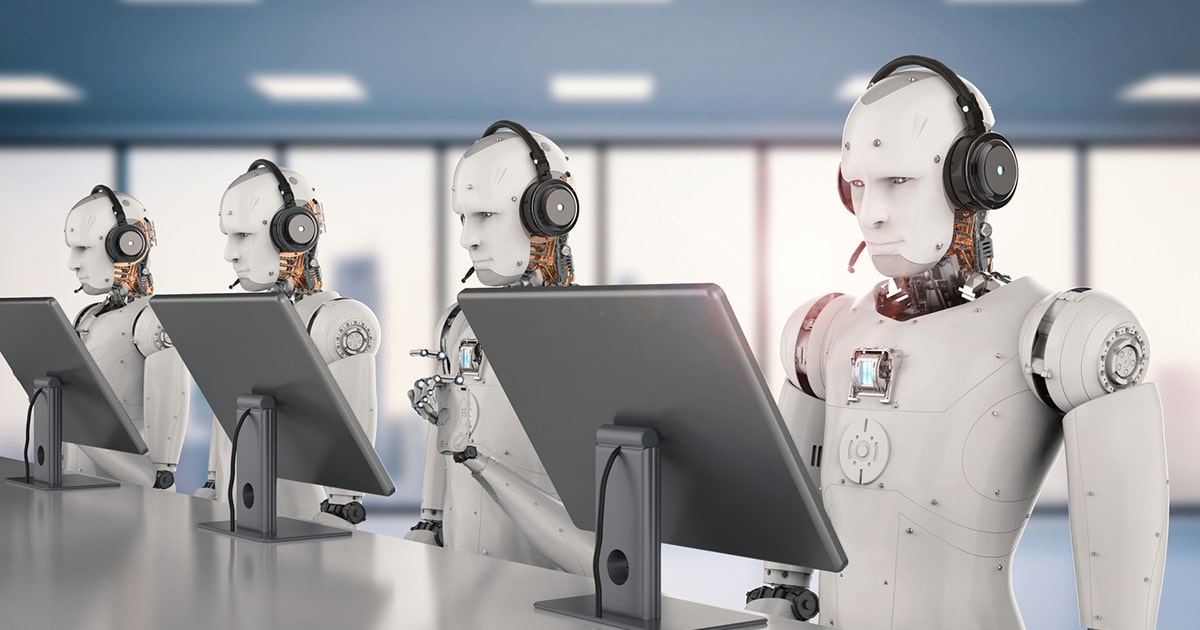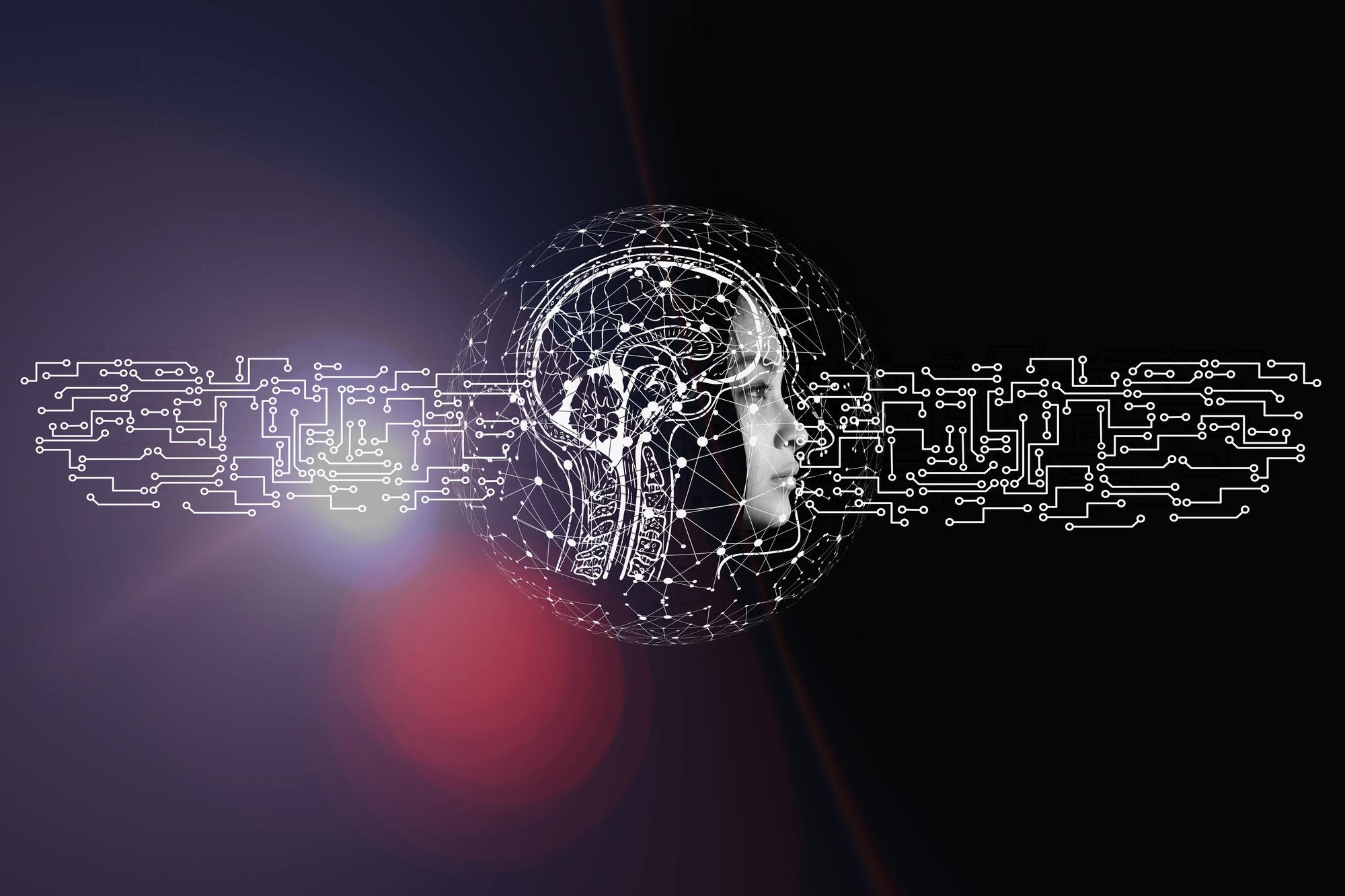Artificial intelligence (AI) is one of those concepts that conjures up polar opposite but equally inaccurate visions of the future. There’s the dark, apocalyptic AI from science fiction movies where an all-powerful computer system gains a level of self- awareness, turns against humanity and unleashes armies of killer cyborgs. There’s also the warm and fuzzy vision, where friendly, helpful humanoid-looking robots tend to all of our wants and needs.
People in the first camp, with images from The Terminator or 2001: A Space Odyssey in mind, hope that AI never happens. And people who can’t wait for their own personal R2-D2 wonder what’s taking so long.
The reality is that AI is already here, not in the form of Skynet or the HAL 9000, but in intelligent software agents embedded in devices we use all the time. According to Aberdeen Research, 43 percent of businesses today are leveraging some form of AI. AI permeates our everyday lives, whether we’re aware of it or not. Every time we ask Siri where to get a hamburger or tell Alexa to play our favorite song; whenever Netflix recommends a movie based on our viewing preferences, or our spam filter gains a little more insight into what types of emails we want to block; and every time we interact on a website with a smart bot that guides us through a complex transaction or procedure, we’re using AI.
There are so many buzzwords and misconceptions associated with AI that it’s important to establish some basic definitions.
AI isn’t about a specific physical form factor, and it’s not about any particular underlying code base or technology. AI is software, however limited or broad in scope, that mimics human intelligence.
As an umbrella term, AI can include neural networks, deep learning, natural language processing and machine learning, in which systems are able to “learn” for themselves. Examples of machine learning are the ever-improving algorithms underlying predictive analysis and recommendation engines.
Some AI systems play chess. Others scan millions of security-related incidents and detect cyber threats. Or analyze video from security or traffic cameras to spot patterns or anomalies. Or provide collision-avoidance features in automobiles. AI diagnostic systems such as IDx-DR can analyze data from complex sets of medical images to diagnose the presence of eye disease. And Danish startup Corti has developed an AI-enabled chatbot that helps emergency dispatchers make life-saving decisions in real time.
AI predictions for 2021 and beyond
By 2021, most major businesses will provide some type of customer experience centered around AI, as companies progress past proofs of concept and move into production. Indeed, IDC forecasts that by 2023 worldwide spending on AI systems will hit nearly $98 billion. IDC says that retail and banking industries will spend the most on AI, with investments targeted at automated customer service agents and diagnostic and treatment systems. For consumers, this means a large portion of their interactions with service providers, such as banks and insurance companies, will be through AI-based smart agents, rather than human beings.
The best approach for businesses exploring how best to take advantage of AI is to be laser focused on customers and their needs, not on the technology. Brainstorm what you want the customer experience to be like and what you want to accomplish with your customers, focusing on their stories. Then use AI as a tool to make that experience happen.
The challenge for companies will be making that leap from the experimental phase to the operational level. Companies need to solve a number of potential challenges, such as how to integrate AI systems with the rest of the organization’s digital platform, as well as how to manage, secure, update and monetize AI in a cost-effective and ethical manner.
The rich and famous
As we try to predict the impact of AI and make it more concrete in our minds, one approach is to think about the lives of the super-wealthy. This very thin sliver of the population can afford to hire people to handle just about every aspect of life, to deal with all of its complexities and to step in when something goes wrong. For example, the very wealthy have their own personal physicians, personal financial advisors and personal travel agents, to name a few. From their clothes to their homes, they can afford to have goods and services custom-made and tailored to their specific preferences and tastes.
The promise of AI is that it can democratize access to services, information and convenience. Companies in virtually every industry can extend the same level of customization and personalized service currently enjoyed by the very wealthy to all of their customers through the deployment of low-cost intelligent agents. These software agents aren’t trying to rule the world or take over our lives, but they have the potential to augment and improve many important aspects of our lives.
The challenge for companies will be making that leap from the experimental phase to the operational level. Companies need to solve a number of potential challenges, such as how to integrate AI systems with the rest of the organization’s digital platform, as well as how to manage, secure, update and monetize AI in a cost-effective and ethical manner.
AI can save companies huge amounts of money by transferring tasks requiring human intelligence from a highly paid person who needs to be recruited, trained and retained to a relatively inexpensive piece of software. Juniper Research predicts that companies will save $8 billion by 2022 through the use of chatbots, particularly banking and healthcare industries. We already understand that software can handle lower-level, data entry-type tasks, and that robots can perform simple, repetitive tasks on the factory floor, but with true AI, intelligent systems can assume the roles of advisors, managers and supervisors in complex organizations and situations.
Here are some of the ways we think AI will transform five key industries over the next 3 years:
Healthcare
If we look at the lives of the wealthy, they might have personal physicians who make house calls; no waiting weeks to get an appointment. They might have personalized healthcare plans based on their family history and their specific medical needs and requirements. They get the most aggressive and comprehensive preventive care. They receive the best medical advice based on the latest research. If they do get sick, they get the highest quality care based on their unique situation. And when they leave the hospital, they receive the best, round-the-clock follow-up care.
Through the development and deployment of AI-infused systems, the healthcare industry of the near future will be able to deliver personalized medical care to all patients. It’s too early to tell specifically how AI-based medicine will manifest itself, but we can easily envision hospitals delivering personalized, tailored healthcare information, such as updates, reminders or suggestions (“Time to get your flu shot!”) to people’s smartphones or smartwatches.
Through the development and deployment of AI-infused systems, the healthcare industry of the near future will be able to deliver personalized medical care to all patients.
Patients might be able to interact with a smart kiosk that seamlessly links their patient history and real-time biometrics information with physicians who are equipped with tablets or other mobile devices. Or patients might be at home, where medical data is collected by internet of things (IoT) devices – such as a wearable digital diabetes monitor – and transmitted wirelessly to a cloud-based AI analytics system that can send alerts to a physician in the event of a potentially dangerous reading.
AI systems can also help make diagnoses in complex cases and can recommend treatment options. One important factor to bear in mind is that AI systems have limitations — they are not all-knowing or infallible. There have been many well- documented instances of AI systems making mistakes because these systems are still, at the core, machines. They sometimes come up short when it comes to understanding context or using what we call common sense. And when they do make a mistake, they aren’t designed for introspection or for analyzing where they went wrong.
In light of those limitations, the preferred approach in a life-or-death medical scenario, for example, would be to use AI to narrow down the options and present recommendations, but to have trained professionals make the final call. This rule of thumb applies to most high-level decisions, from self-driving cars to a manufacturing scenario — AI works best when it is deployed alongside people, who can apply context, common sense and creativity.
AI does have the edge over humans when it comes to analyzing large data sets, so in a hospital setting, for example, AI systems can look at data from multiple patients with a similar diagnosis or medical history to spot patterns and identify best practices.
Overall, AI will enable the healthcare industry to provide better preventive care, reduce the length of hospital stays and provide more effective follow-up care based on the individual needs of the patient, while cutting costs.
Travel, transportation & hospitality
If you’re one of the super-wealthy, you might have a personal assistant who handles your travel and transportation activities, making reservations for flights, rental cars, hotels and restaurants based on your personal preferences. And most importantly, stepping in when something goes wrong — when a flight is canceled, for example — and making alternate arrangements. Companies in the travel and tourism industry that offer AI-enabled traveler personalization features – such as those enabled by a digital agent or smart ticketing system – will be able to gain an edge over competitors.
The transportation industry is on the verge of being disrupted by another AI- based technology — self-driving or autonomous vehicles.
Those same AI capabilities can be applied to a variety of related industries, such as long-haul trucking, air, sea and rail-based shipping, and localized delivery services. AI can help companies squeeze inefficiencies out of these logistics-heavy industries throughout the entire supply chain, from the loading dock to the distribution center to determining the best route the vehicle should take on the way to its destination. With AI, companies can reduce costs and overcome labor shortages while delivering better services to customers. AI, for example, can reroute shipments when there is a potential disruption in the supply chain.
The transportation industry is also on the verge of being disrupted by another AI- based technology — self-driving or autonomous vehicles. Self-driving trucks are already hitting the highways, and despite some early bumps in the road, self-driving vehicles are poised to have a profound effect on a number of sectors, including public transportation, delivery vehicles and personalized ride services, particularly for populations like the elderly or handicapped.
Manufacturing
Continuing with the über-wealthy analogy, but with a slight twist, large companies that outsource the manufacturing of their products get personalized service up and down the supply chain because of their size. To win a contract from a Fortune 500 company, a manufacturer might modify its processes, purchase new equipment and do whatever it takes to accommodate the needs of the customer. This applies to manufacturers that deliver goods to retailers such as Walmart or Home Depot, as well as manufacturers that are part of the larger supply chain of a company such as GM or Boeing.
But with AI-based intelligent systems, manufacturers of all sizes could extend tailored services to all of their customers, including the smallest “mom-and-pop” companies. AI gives manufacturers the ability to take a proposal and apply AI analytics to come back to the customer with ideas for improving the product design, optimizing the supply chain and even moving to a more efficient, real-time manufacturing model. And the “mom-and-pop” business has access to affordable technology previously available only to larger companies, enabling it to innovate and improve its business.
With AI-based intelligent systems, manufacturers of all sizes could extend tailored services to all of their customers, including the smallest “mom-and-pop” companies.
AI can play a role throughout the manufacturing process. Intelligent systems can help with product creation and design. Digital twin simulations can improve and optimize manufacturing processes. And IoT sensors on the factory floor can connect to AI systems that can detect and predict potential maintenance or product quality issues. And with AI, companies can analyze data on how customers are using the product and how the product can be improved based on everything from real-time usage data to social media posts.
Banking
With AI, financial institutions could provide personal services to all customers.
The super-rich have their own financial advisors, who understand their goals, their risk tolerance and the range of investments they might be comfortable with. A financial advisor goes beyond simply managing an existing investment portfolio and takes the initiative to identify new opportunities or to change course based on shifting economic trends. With AI, financial institutions could provide a similar level of personal services to all customers – enabled by chatbots, for example – to facilitate customer interactions and access to financial services. The result could be significant cost savings and increased revenue opportunities for banks, and a more personalized, financially advantageous banking experience for customers.
Insurance
Similarly, the very wealthy have the basic types of insurance we all have on their cars or homes, but they also have access to creative and personalized types of insurance that help protect against other types of risk and also incentivize them to engage in activities that they might not otherwise do. Eventually, that same model could be applied to the average consumer to reduce the risk associated with certain types of transactions. For example, you might not feel comfortable buying a used cell phone from a stranger over the internet, but you would if you could get insurance on that phone.
Insurance companies could deploy AI to correlate various types of actuarial information, driving history, etc., to gain insight into their customers and to offer them personalized services.
Insurance companies could also deploy AI to correlate various types of actuarial information, driving history, etc., to gain insight into their customers and to offer them personalized services. Beyond simply evaluating risk, we could see insurance companies using AI to proactively subsidize safer behavior for everyone, such as correlating driving data from your car’s braking system with lower auto insurance rates, or providing people with incentives to work out or lose weight.
We believe that the next few years will see an acceleration in the deployment of embedded AI systems across virtually all industries and into all aspects of our daily lives. Rather than being something to fear, the democratization of AI will enhance everyone’s life in ways that we have predicted, as well as in new ways that we can’t even imagine.
This feature is sourced from DXC.technology





